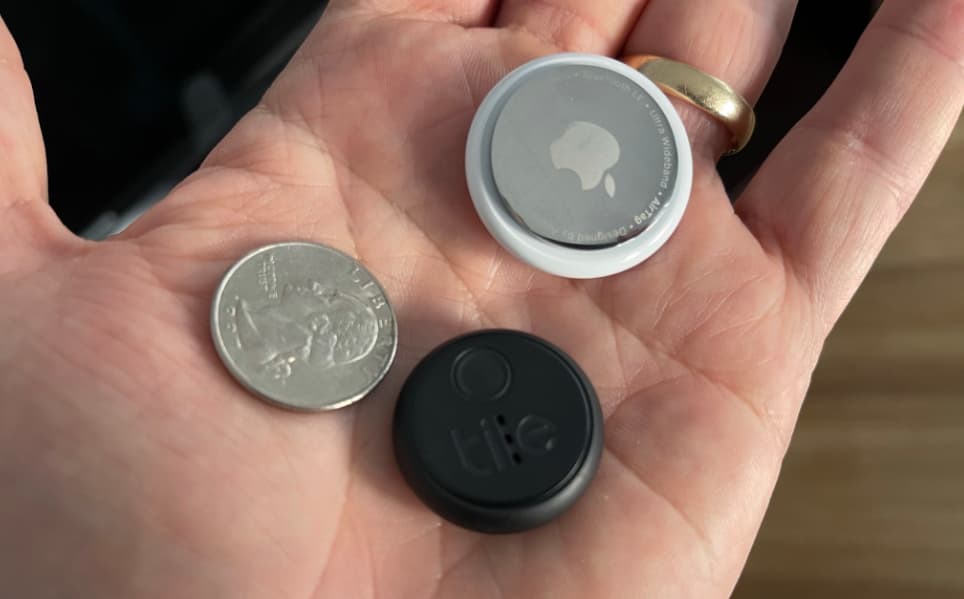Apple‘s $29 AirTag lost-item tracker begins shipping on April 30. I walked through what it’s like last week, but I recently bought a similar tracker from Tile. Tile has been in the lost-item tracking business for several years, and now counts Apple as its closest competitor.
I took both devices for a test drive to show you how they differ and to help explain why Tile is so upset that Apple is moving in on its turf.
Tile trackers aren’t new. They’ve been around for years and have been leading the market. Owners seem to love them. They’re convenient because you can attach them to bags, keys or other items, and then see where they are on a map on your phone.
Like AirTag, Tile trackers don’t use GPS. Instead, they rely on a network of other Tile devices that communicate with each other over Bluetooth. So, the more Tile devices there are out there, the greater your chances that someone with a Tile passes by yours and alerts your phone of your lost item’s location. Tile has sold more than 35 million devices, not including products from more than 30 partners with its technology built-in, which make up its network that spans 195 countries.
Apple’s AirTag is similar, except it taps into not only other AirTags but also Apple’s existing network of iPhones and Macs, which is nearing a billion devices. That gives Apple an advantage over Tile from the get-go, since it has a bigger network at launch, even if lots of people don’t buy an AirTag.
Here are a few of the things I like about Tile that you don’t get with Apple AirTag:
- There’s a button on it you can press to ring your phone, in case you can’t find it around the house.
- There are several sizes and shapes. I bought a $25 Tile Sticker that’s about the size of a quarter, a hair smaller than an AirTag. You can stick it to anything. AirTag requires a keychain or a separate holder.
- Speaking of sizes, Tile sells a $29.99 “Slim” model that looks like a credit card and slips into a wallet. The Slim and Sticker models have up to 3 years of battery life, which is longer than the one year you get from Apple. But, the Pro and Mate versions of the Tile tags — the Pro has a louder speaker and longer Bluetooth ran than the Mate — have user-replaceable batteries, which last a year, like AirTag.
- Tile has a bunch of colors, including limited-edition options with patterns that you might like if you don’t want a white and silver AirTag that can only be customized with a few letters or an emoji.
- Tile works with Android and iPhone, so you can still track stuff even if you don’t use an iPhone.
- Tile’s tracking tech is built into other products, from earbuds to laptops and retainer cases.
But the biggest difference is the experience. AirTag is a lot more seamless since you just pull the battery tag and click “connect” on your iPhone.
With Tile, you need to download a separate app, instead of using Apple’s Find My which comes pre-installed on all of its devices, then give the app permission to use your location twice during setup. It’s something Tile has complained to Congress about because the company thinks Apple’s own product has the advantage here.
And while Apple’s Find My network is open to other companies that want to support it, it’s not in Tile’s best interest to do so.
Tile, for example, lets you find lost devices nearby and far away for free. But its subscription services, including Premium ($2.99/month or $29.99 a year) and Premium Protect ($99.99 a year), rely on its network, not Apple’s. That’s why it probably isn’t as excited to launch devices that support Apple Find My as companies that aren’t in the tracking space at all.
The Premium plan can help you get smart alerts if you leave something behind, includes a free battery replacement, lets you share a tracker’s location with friends, shows a 30-day location history and more. Premium Protect includes those features and offers up to a $1,000 item reimbursement if you can’t find it, so it’s kind of like an insurance program for your stuff.
AirTag owners who use an iPhone 11 or iPhone 12 model also get another advantage from AirTag. Those phones can locate the AirTag right down to its exact location using an ultra-wideband signal. You just hold up your phone and it points you in which direction to walk to find your lost item. Tile doesn’t have access to this part of the iPhone, even though it developed support for its trackers, so it can’t offer this feature. It’s one of the complaints the company has had with Apple rolling out its own tracking product and it brought this up just last week with Congress.
Another differentiator: AirTag also has privacy controls. It will alert you if someone else’s AirTag seems to be with you, instead of with them, for too long. That might help prevent people from using them to track you.
It’s up to you which one to buy. I like the sticker and form factors of Tile and that I can ring my phone by pressing a button on it. It also works on Android, which is a big benefit. Apple’s AirTag is a hair faster to set up, has ultra-wideband, and it has a bigger network that might make it easier to find your lost device since there are more people with iPhones and Macs than Tile trackers.
Subscribe to CNBC on YouTube.
